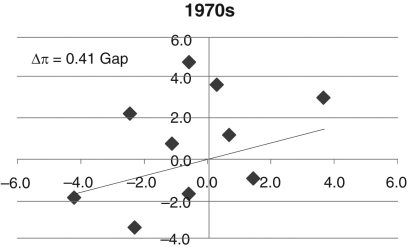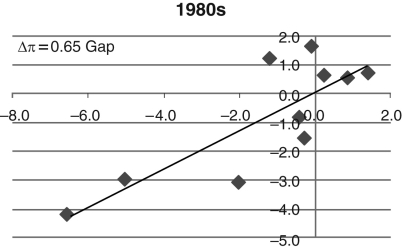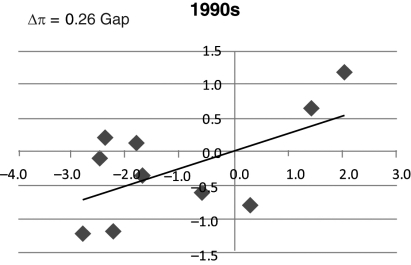Consider the following three figures, which show the Phillips curve relationship for the 1970s, 1980s, and 1990s. The output gap is on the x-axis and the change in inflation, , is on the y-axis. Explain what each of these Phillips curves tells us about each of the three decades. In which period would fighting inflation be the most difficult?Figure 9.9: Phillips Curve Relationship, 1970s 
Figure 9.10: Phillips Curve Relationship, 1980s 
Figure 9.11: Phillips Curve Relationship, 1990s 
Definitions:
Discrimination
Unfair treatment of a person or group based on characteristics such as race, gender, age, or sex, rather than individual merit.
Legal Situations
Circumstances or cases that involve or are subject to laws, legal processes, or legal interpretations.
Disparate Impact
A phenomenon where a policy or practice appears neutral but disproportionately affects individuals of a certain group, often used in discussions of employment discrimination.
Four-Fifths Rule
A guideline used in the United States to assess discrimination in employment practices, indicating potential bias if a selection rate for any race, sex, or ethnic group is less than four-fifths (80%) of the rate for the group with the highest selection rate.
Q10: In contrast to the dot-com stock market
Q18: The velocity of money is defined as
Q30: Consider the data in Figure 10.1. What
Q39: Empirically, a large amount of evidence suggests
Q63: When economists say "sticky inflation," they mean:<br>A)
Q63: The essence of the quantity theory of
Q78: In growth accounting, if we subtract the
Q92: The name given to low-quality loans is:<br>A)
Q93: If there is an aggregate demand shock:<br>A)
Q110: Every six to eight weeks, or so,